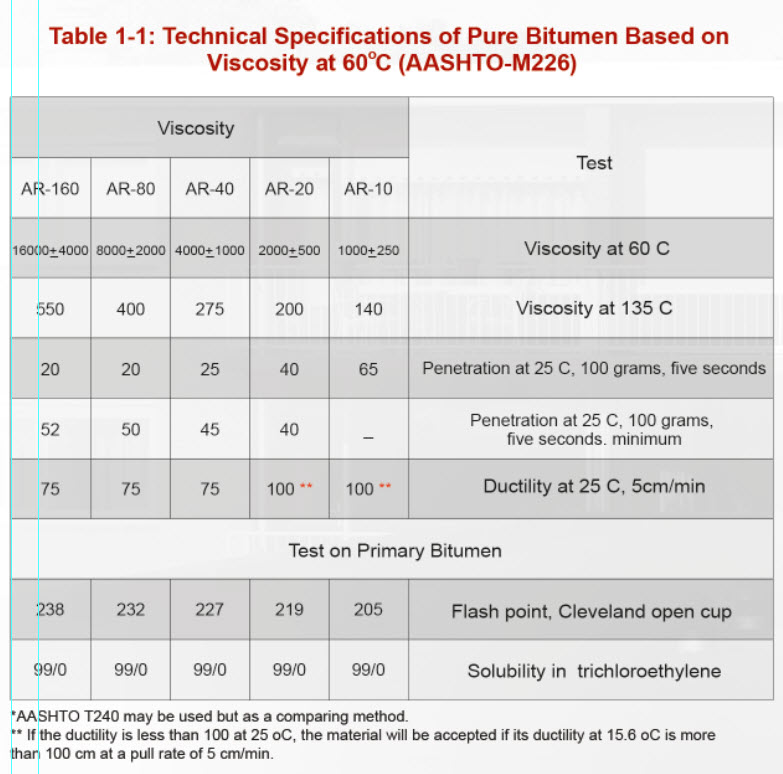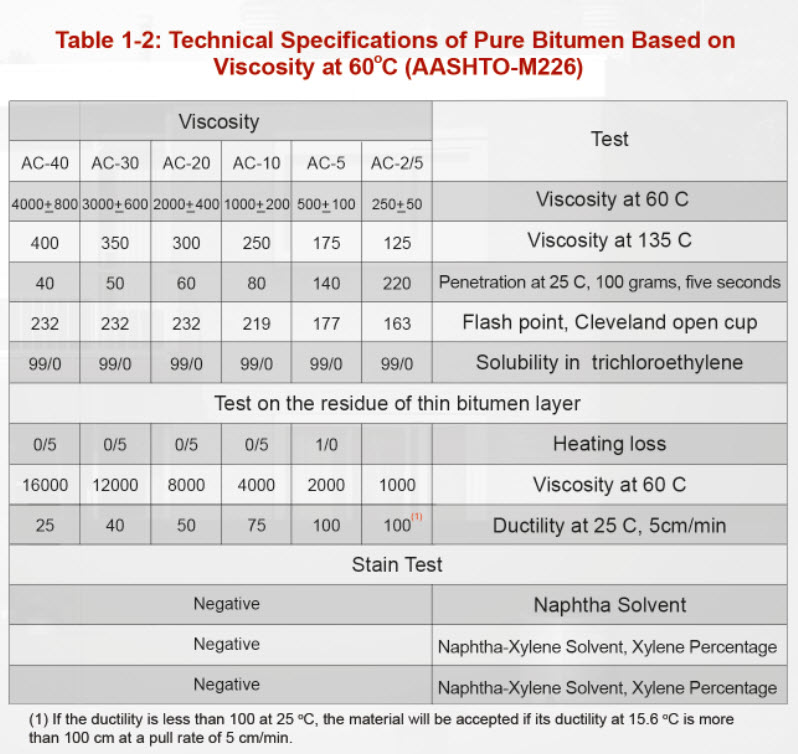
Definition of Viscosity Grade Bitumen, (VG Bitumen)
Viscosity Grade Bitumen (VG Bitumen) is tested differently from other types and grades of bitumen. Globally known as viscosity testing, this testing method has been introduced to the industry in order to make the behavior of bitumen predictable at various temperatures.
In comparison to the well-known penetration testing, viscosity testing is more accurate. This test results in the grading of bitumen into four grades named as VG10, VG20, VG30, and VG40. A few qualification tests like specific gravity, water content, ductility, loss on heating & fares breaking point were removed from IS:73-1992 as these tests do not have any relationship with the performance of the product. The higher the number of the grade, the stiffer the Bitumen.
Due to its durability and reliability, this type of bitumen is highly used in Australia and India. Applying these grades of bitumen provides you with less temperature susceptibility and better performance of the asphalt, as a result.
Known also as VG, this type of bitumen is the result of testing the viscosity level of bitumen. By this method of testing, the consistency of bitumen, meaning bitumen’s ability to flow, is measured in both 60° C and 135° C. This test temperature stands for the maximum bitumen temperature in hot summer and the temperature of bitumen when mixed.
Viscosity Grade Bitumen (Asphalt) is a Bitumen grade mostly used as a Paving Grade and it’s suitable for road construction and for the asphalt pavements producing with premier attributes. VG Bitumen is usually used in the production of hot mix asphalt.
Viscosity Grade Asphalt is petroleum grade bitumen, which produced from fractional vacuum bottom which comes from the distillation of crude oil, which feasible appliance and behavior changes according to its temperature.
Bitumen Viscosity Grade is specified by ASTM Standard D3381-09 and AASHTO M226-80 (2008). VG Bitumen specifications cover by Viscosity at 60 ̊C (140 °F).
We have two methods of grading:
- Standard Bitumen Viscosity Grade (AC-Grades), in which the Viscosity of the standard bitumen (asphalt) is measured at 60 ºC (140 ºF).
- RTFOT Bitumen Viscosity Grade (AR-Grades), in which the Viscosity of bitumen (asphalt) is measured at 60 °C (140 °F) after the roll on thin-film oven test.
Viscosity grade bitumen has a thermoplastic feature which causes the material to soften at high temperatures and to harden at lower temperatures. This temperature viscosity relevance is significant when specifying the performance parameters such as the adhesion, rheology, durability, and application temperatures of bitumen. In the Viscosity Grade Bitumen specifications, the most important emphasize is based on the Bitumen ductility.
Bitumen Viscosity grade was introduced in the 1970s. In order to increase the reliability of bitumen in higher temperatures and prevent the pavement from rutting, engineers identified more rational parameters (less empirical) for measuring bitumen behavior.
From 1970 onwards, viscosity grading becomes popular among both traders and engineers. There are several advantages that convinced consumers across the world to prefer this grade of bitumen to the old-fashioned penetration grading system.
In what comes below, we provide you with more details on the difference between penetration and bitumen viscosity grade.
Uses of Viscosity Grade Asphalt
Viscosity-grade bitumen is widely used in spraying applications such as surface-dressing and paving in a very cold climate. It is also used to manufacture bitumen emulsion and modified bitumen products.
VG-10: is mostly used in spraying applications such as surface dressing and Paving in a very cold climate instead of 80/100 penetration bitumen grade. It is also used to produce Bitumen Emulsion and Modified Bitumen products.
VG-20: is used for paving in cold climate & high altitude regions.
VG-30: is especially used to construct extra heavy duty Bitumen pavements that need to tolerate significant traffic loads. It can be used instead of 60/70 penetration bitumen grade.
VG-40: is used in highly stressed areas such as intersections, near toll booths, and truck parking lots instead of 30/40 penetration grade. Because of higher viscosity, stiffer Bitumen mixes can be produced to amend resistance to shoving and other problems related to the higher temperature and heavy traffic loads.
Advantage of VG Bitumen than Penetration Bitumen
- The same rutting performance is given by the binders of the same viscosity grade, unlike the case of penetration grades.
- The viscosity grading system retains minimum performance in terms of fatigue cracking. This will enable acceptable performance. This is for an average yearly temperature of 25 degrees.
- The potential on tender mixes can be minimized with the minimum specified values of kinematic viscosity at a temperature of 135 degrees Celsius.
- The maximum allowable temperature susceptibility can be established by specifying the minimum value of penetration at 25 degrees and the kinematic viscosity at 135 degrees.
- For a wide variety of temperatures, the viscosity binders were employed. A temperature of 60 degrees for rutting, 25 degrees for raveling or fatigue problems, or 135 degrees for construction activity.
- The suppliers can provide users with accurate asphalt mixing and temperature values for construction. This is possible because of the measurement of viscosity at two temperatures.
Asphalt viscosity grade is globally preferred to penetration system of grading, mainly because it is more accurate.
This type of classification is based on the understanding of bitumen behavior and its functional properties, with different characteristics of cracking and deformation due to cold, heat, and fatigue. To do so, experts in the lab measure the consistency of bitumen in two phases.
In the first phase of the viscosity grading test, the penetration of bitumen at 25° C is measured. Since the penetration test only measures the stiffness of bitumen in average temperature, its results are not reliable in hot summer days. That’s why we complete the testing procedure by calculating the viscosity of bitumen in the second phase.
In the second phase, we calculate the viscosity of bitumen at 60° C (Absolute Viscosity), and then the viscosity ratio to density is calculated at 135° C (Kinematic Viscosity).
Comparison Standards of VG Bitumen
Standard Absolute and Kinematic Viscosity
For measuring the viscosity of bitumen, there are two methods known as absolute (or dynamic) viscosity and kinematic viscosity.
In absolute viscosity, the level of bitumen’s resistance to flow is measured in 60° C, but kinematic viscosity is the viscosity to density ratio in 135° C.
The difference between these two types of viscosity grading is that the absolute viscosity predicts the characteristics of bitumen in a hot summers, but the kinematic viscosity predicts the bitumen performance in a hot mix asphalt.
These grading test results are VG10, VG20, VG30, and VG40 that are more popular in Asian and African countries.
Viscosity Grading Based on AASHTO Standard
Another type of viscosity testing bitumen is based on the specifications defined by American Association of State Highway Officials (AASHTO).
This organization introduced two series of viscosity grade bitumen.1) Standard viscosity grade or (AC grades) which is the result of measuring the viscosity of the standard bitumen (asphalt) at 60° C.
Six asphalt cement viscosity grades were established as AC-2.5 (softest), AC-5, AC-10, AC-20, AC-30, AC-40 (hardest). Low viscosity grades are used in cold climate while the high ones are generally suitable for the hot climate.
2) Aged residue or (AR grades) in which the viscosity test is done on an aged residue sample of bitumen at 60° C.
Technical Specification of Pure Bitumen Based on Viscosity on 60 C (AASHTO M-226)



